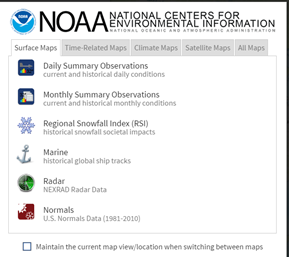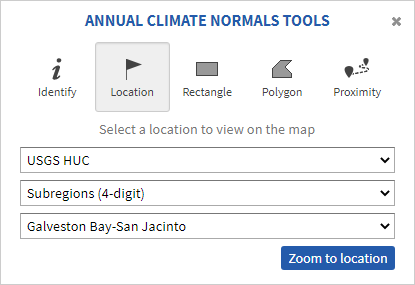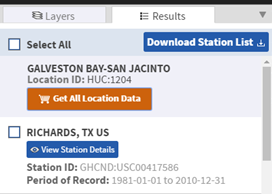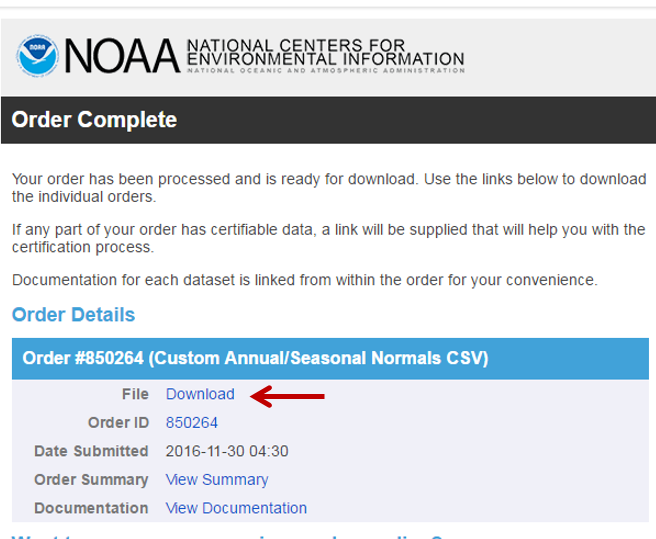...
Now you will download rain gauge station data created by the National Climatic Data Center (NCDC) using the Climate Data Online (CDO) interface.
- In a web browser, go to www.ncdc.noaa.gov/cdo-web/.
- Click the Mapping Tool tab.
...
- On the Surface Maps tab, click Normals.
- In the left sidebar, on the Layers tab, uncheck Daily Climate Normals, and check Annual Climate Normals.
- To the right of Annual Climate Normals, click the Map Tools button.
- In the new ‘ANNUAL CLIMATE NORMALS TOOLS’ window, click Location Location.
- Use the drop-down menu to select USGS USGS HUC.
- Use the ‘Select a HUC type’ drop-down menu to select Subregions Subregions (4-digit).
- Use the ‘Select a HUC’ drop-down menu to select Galveston Galveston Bay-San Jacinto.
- Click Zoom to location.
- The left sidebar switches to the Results tab. Click Get All Location Data.
- For Step 1, select Custom Annual/Seasonal Normals CSV for the output format and click CONTINUE.
- For ‘Station Detail & Data Flag Options’, check Station name Station Name, Geographic locationLocation, and Include data flags Data Flags to include those variables the data table.
- For ‘Select data types for custom output’, clickexpand the Annual Precipitation category to expand it.
- Check Long Long-term averages of annual precipitation totals (ANN-PRCP-NORMAL).
- At the bottom of the window, click CONTINUE CONTINUE.
- Type your email address twice and click SUBMIT SUBMIT ORDER.
Check your email. You should receive two emails a couple minutes apart, although it may take a few hours to receive the second email. The first one indicates that your data request was submitted and the second one includes the requested data.
- In your email, click the Download link to download the requested CSV file.
Excel
- Navigate to the location where the CSV file was stored.
- Double-click the CSV file to open it using Excel.
The first column contains the unique station identification code and the second column contains the station name. Next are the elevationlatitude, latitudelongitude, and longitude elevation of the stations. The annual precipitation field contains long-term averages of annual precipitation totals in hundredths of inches. More information is available on the Data Set Documentation and Samples Datasets portion of the CDO website. The annual precipitation field "
| Info |
|---|
As of March 7, 2021, the CSV download includes ALL climate variables, even though only ANN-PRCP-NORMAL |
...
was selected for download. In this case, the annual precipitation field, ANN-PRCP-NORMAL, will not appear in column F, after the ELEVATION field. Instead, it appears in column BP. In this case, you will need to copy and paste the data from column BP to column F. |
Before opening this table in ArcGIS, you must reformat some of the field names, which cannot have special characters and must are recommended to be 13 characters or less.
- Rename “ANN-PRCP-NORMAL” to “ANNPRCPHIANNPRCP_HI”, for annual precipitation in hundredths of inches.
- Along the top of the worksheet, drag across the column letters to select columns A through H F.
- Copy the selected columns.
- At Along the bottom left of the worksheet, click click the "plus" icon to New sheet button
to create a new sheetworksheet. In the cell A1 cell, paste your previously copied columns.
- Delete the previous sheet.
- Along the top of the worksheet, drag across the drag across the column letters to select columns A through H F.
- Hover your mouse between columns G E and H F until the cursor changes to two outward facing arrows and double-click to auto-size the column widths.
- At the bottom left of the worksheet, rename the worksheet “PrecipStations”from Sheet1 to “PrecipStations”.
- Click the File menu and select Save As.
- Navigate to your HydrologyLab folder.
- For ‘File name:’, type "PrecipStations".
- Use the ‘Save as type:’ drop-down menu to select Excel 97-2003 Workbook.
- Click Save.
- Close Excel.
...
Now you are ready to start a new map document and display the tabular rain gage data you just downloaded.
- Return to ArcGIS Pro.
- Click the Insert menu and select New Map.
- Click “Map1” in the contents pane to rename it as “Lab2Precip”“Lab2Precip”. Click Save.
- Drag Watersheds_StateplaneStatePlane onto the map display.
- Click the Geoprocessing tab and search for ‘Excel to Table’.
- For the Input Excel File, selectPrecipStations. Rename the output table PrecipStations.
- Click Run.
- In the Contents pane, right-click the PrecipStations table and select Display XY Data.
- For ‘X Field:’, select the LONGITUDE field.
- For ‘Y Field:’, select the LATITUDE field.
- Click the Atlas to the right of the Spatial Reference boxFor 'Spatial Reference, click the Browse button.
Because the coordinates are in the form of latitude and longitude in decimal degrees, you know you will need to select a geographic coordinate system, rather than a projected coordinate system. While the data could theoretically be in any geographic coordinate system, you will select the North American Datum 1983, commonly abbreviated NAD 83, because this is coordinate system of the data provided on the NCDC website.
- Double-click Geographic Geographic Coordinate Systems > North America > USA and Territories.
- Select NAD NAD 1983 and click OK OK.
- Ensure that your window matches that below and click Run Run.
The points should now appear on top of the watersheds, though they also extend beyond the watersheds in the Buffalo-San Jacinto subbasin, since we downloaded them for the entire Galveston Bay-San Jacinto subregion.
...
Since the points appear to be in reasonable locations (rather than in another country or the middle of the ocean), you will want to export them to a new feature class in your ElevationRainfall geodatabase. Exporting to a feature class will allow you to reuse this points layer in other future map documents without having to go through the display XY data process each time.
- Right-click the PrecipStations_Layer layer and select Data > Export Features.
...
- Next to ‘Output feature class’, click the Browse button.
- Navigate to the HydrologyLab geodatabase.
- Double-click your HydrologyLab geodatabase to save your feature class in it.
- For ‘Name:’, type “PrecipStations_Features” and click Save.
- Click Run.
Since you are now using a permanent feature class, you may remove your temporary Events layer and the corresponding Excel table.
- Right-click the PrecipStations_Layer layer and select Remove.
- Right-click the PrecipStations table and select Remove.
Projecting vector data
...
- At the top of the Geoprocessing window, click the Environments tab on the right.
- For Extent, use the drop-down menu to select Current Display Extent and go back to Parameters.
- For ‘Input Features’, drag in the PrecipStations_StatePlane layer.
- For ‘Output Feature Class’, rename the feature class from “PrecipStations_StatePlane_Cr” to “PrecipThiessen”.
- Use the ‘Output Fields’ drop-down menu to select All fields.
- Ensure your ‘Create Thiessen Polygons’ window appears as shown below and click Run.
You will notice that polygons now fill the entire Map Display indicating which areas are closest to which rain gages.
- Open the PrecipThiessen layer attribute table.
Notice that all of the fields that you originally downloaded from CDO are still included, because you selected to output all fields when running the Create Thiessen Polygons tool. If you do not see all of the same fields, re-run the tool and this time output all fields.
- Close the Table.
Intersecting two polygon layers
...
- In the Analysis Tools toolbox, click the Overlay toolset then the Intersect tool.
- For ‘Input Features’, drag in the PrecipThiessen and the Watersheds_StatePlane layers.
- For ‘Output Feature Class’, rename it from “PrecipThiessenPrecipThiessen_Intersect” Intersect to “ThiessenWatershedIntersect”“ThiessenWatershedIntersect”.
- Ensure your ‘Intersect’ window appears as shown below and click Run.
- Remove the PrecipThiessen layer from the Contents pane.
- Zoom to the ThiessenWatershedIntersect layer.
The resulting layer integrates all of the boundaries from both the Thiessen polygons and the watersheds, limited to the extent of their overlap.
- Open the ThiessenWatershedIntersect layer attribute table.
Notice that the original 8 watersheds have now been divided into 42 sections indicating which areas of each watershed are closest to each rain gage. Let Pk denote the annual precipitation associated with each rain gage and Aik denote the area of the intersected polygon associated with rain gage k and watershed i. The area weighted precipitation associated with each watershed is
You will add a new field to the table to calculate the elements of the numerator of the equation.| - Click the Add Field… button on top of the table display.
- For ‘Name:’, type “APProd” “APProd”.
- Use the ‘Type:’, drop-down menu to select Double and click Save on the Fields tab.
- Right-click the APProd field name and select Calculate Calculate Field.
- Using the fields and buttons or by typing, enter “!ANNPRCPHI! * !Shape_Area!”.
Ensure your ‘Field Calculator’ appears as shown below and click RunRun.
The APProd field now contains the numerator values in the equation. You are now ready to summarize the calculated statistics by watershed.
...
Right-click the HU_10_NAME field name and select Summarize… Summarize….
For statistics fields, use the drop-down menu to select the Shape_Area field and select Sum Sum.
- Select the APProd field and select Sum Sum.
- For ‘Output Table’, rename the table from “ThiessenWatershedInteractThiessenWatershedInteract_St” St to “WatershedPrecip”“WatershedPrecip”.
- Ensure your ‘Summarize’ window Geoprocessing pane appears as shown below and click Run Run.
The resulting table gives the numerator and denominator in the equation for each watershed.
- Open the WatershedPrecip table.
Repeating the techniques you just learned, add a new field to the WatershedPrecip table called “Precip” of type double. Use the field calculator to evaluate [Sum_APProd]/[Sum_Shape_Area]. The result is the precipitation for each subwatershed. Export the table to Excel and format it. Also include the mean annual precipitation over the entire watershed.
...
- Turn off the ThiessenWatershedIntersect layer.
- Right-click the Watersheds_StatePlane layer and select Zoom to Layer.
- Open Toolbox.
- In the Spatial Analyst Tools toolbox, click the Interpolation toolset then the Spline tool.
- On the top of the window, click the Environments tab.
- For Extent, use the drop-down menu to select Current Display Extent.
- Use the ‘Mask’ drop-down menu to select the Watersheds_StatePlane layer.
- Go back to Parameters. For ‘Input point features’, drag in the PrecipStations_StatePlane layer.
- Use the ‘Z value field’ drop-down menu to select the ANNPRCPHI field that contains the values you wish to interpolate.
- For ‘Output raster’, rename the exported raster from “SplineSpline_Preci1” to Preci1 to “AnnPrecip”.
- Use the ‘Spline type’ drop-down menu to select TENSION.
- Ensure your Geoprocessing pane appears as shown below, and click Run.
...




















